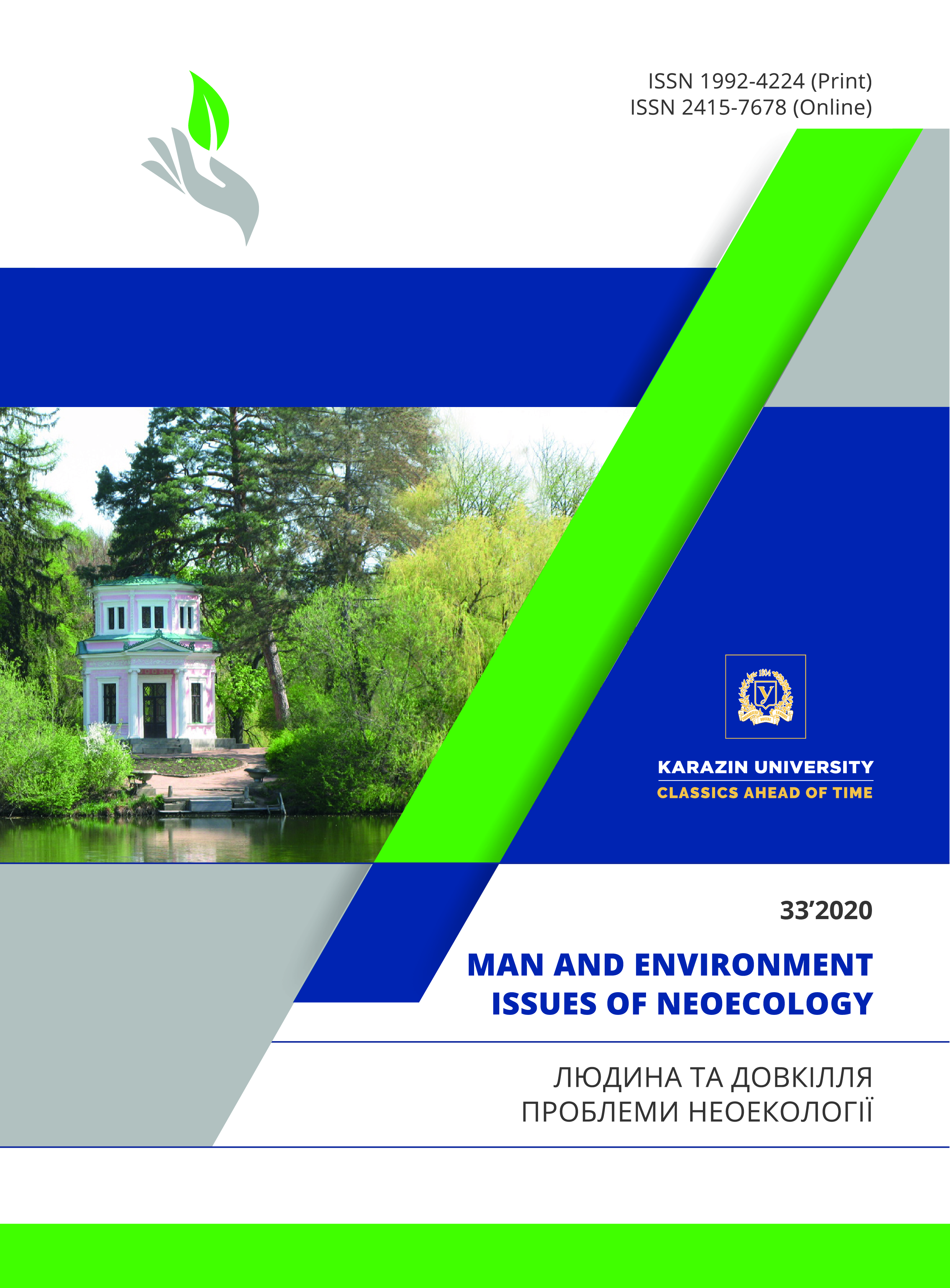Особливості геоекологічного стану басейнової системи озера Озерянське (Волинське Полісся)
Анотація
Мета. Розкрити особливості геоекологічного стану озерно-басейнової системи (ОБС) оз. Озерянське для потреб збалансованого природокористування.
Методи. Польові інструментальні, ландшафтно-геохімічні, геоінформаційні, лабораторно-аналітична діагностика проб ґрунтів, води та донних відкладів озера.
Результати. З’ясовано сучасний стан господарського освоєння водозбору оз. Озерянське. Представлено результати дослідження гідрохімічного складу води озера. Проаналізовано результати експериментів з визначенням вмісту та особливостей радіальної та латеральної міграції рухомих форм біогенних елементів (N, P2O5, K2O), важких металів (Со, Pb, Cd, Cu, Zn, Mn) на ландшафтній ґрунтово-геохімічній мікрокатені в межах водозбору озера. Зафіксовано незначне перевищення ГДК за вмістом Mn і Cd в ґрунтах мікрокатени. Особливістю латеральної міграції біогенних елементів є збільшення їх концентрації від елювіальної до супераквальної фації геохімічної мікрокатени, а радіальною – зменшення їх вмісту з глибиною ґрунтового профілю. Для рухомих форм важких металів (Со, Pb, Cd, Cu, Mn) характерною особливістю є радіальна міграція – підвищення їхнього вмісту з глибиною ґрунтового профілю в горизонті (20-40 см), а далі в напрямку до материнської породи їх концентрація переважно зменшується.
Висновки. Встановлено, що водозбір оз. Озерянське відноситься до антропогенно-природного (ІV) типу та має незадовільний геоекологічний стан. Для покращення геоекологічного стану водозбору доцільно поступово збільшувати площі екостабілізуючих угідь (луки, ліси, кормові угіддя); контролювати норми внесення мінеральних добрив та використання пестицидів, а також заборонити розорювання земель 50-100-метрової прибережної захисної смуги навколо озера.
Завантаження
Посилання
Titenko, G. V. & Kulik, M. I. (2012). The humus horizon of urban soil as a geochemical barrier in the urban landscape. Man and environment. Issues of neoecology. (1-2). 130-136. Retrieved from https://periodicals.karazin.ua/humanenviron/article/view/933 (in Ukrainian).
EU Water Framework Directive 2000/60/EC. (2000). Official Journal of the European Communities 22.12.2000. 327/1-72. Retrieved from https://eur-lex.europa.eu/resource.html?uri=cellar:5c835afb-2ec6-4577-bdf8-756d3d694eeb.0004.02/DOC_1&format=PDF
Kovalchuk, I., Lyko, D. & Martyniuk, V. (2016). Geoecological problems of lake systems of Ukrainian Polesie. WaterLand - 2016: 1st International Scientific Conference, June 6-12. Kaunas: Academy, Lithuania. 44–47. Retrieved from https://docplayer.ru/45701622-International-scientific-conference-waterland-international-scientific-conference-mezhdunarodnaya-nauchno-prakticheskaya-konferenciya.html (in Russian).
Martyniuk, V. O. (2018). Evaluation of geo-ecologically existing natural-technogenic lake-basin system. Scientific Records of the Ternopil National Pedagogical University named after Volodymyr Hnatyuk. Series: Geography. Ternopil, (1), 137-146. Retrieved from http://geography.tnpu.edu.ua/wp-content/uploads/2018/08/22.pdf (in Ukrainian).
Maksymenko, N. & Mykhailova, K. (2013). GIS-simulation of agricultural landscapes for the landscape planning. Man and environment. Issues of neoecology, (3-4), 94-104. Retrieved from https://periodicals.karazin.ua/humanenviron/article/view/1001 (in Ukrainian).
Lyko, D. V., Martyniuk, V. O., Lyko, S. M., Osnitskaya, N. O. & Lysyuk, K. V. (2015). Geoecological assessment of migration of substances within catchments by soil microcatenos (on the example of the Sluch river basin). Visnyk of the V.N Karazin Kharkiv National University. Series Ecology, 13, 26–38. Retrieved from https://periodicals.karazin.ua/ecology/article/view/5532 (in Ukrainian).
Martyniuk, V. O. (2012). Modeling of migration processes occurs in basin geosystems of Volyn Polissya lake. Physical Geography and Geomorphology, 2 (66), 230–240 (in Ukrainian).
Zubkovych, I., Martyniuk, V. & Andriichuk, S. (2019). An assessment of the geoecological status of Radozhychi lake basin system using geoinformation technologies. Visnyk of the East European Lesya Ukrainka National University. Series: Geographical Sciences, (9 (393)), 27-36 (in Ukrainian)
Lyko, D. V., Zubkovich, I. V., Martyniuk, V. O. & Lyko, S. M. (2018). Evaluation of geoecological processes in the basin system of Ostrovske Lake (Volyn Polissya). Visnyk of the National University of Water and Nature Management. Agricultural Sciences Series, 2 (82), 3-14 (in Ukrainian).
Martyniuk, V., Zubkovich, I. & Andriichuk, S. (2018). Estimation of the Geoecological status of the Great Lakes (Volyn Polesie). Science. Visnyk of the East European Lesya Ukrainka National University. Series: Geographical Sciences. (10 (383)). 38–45. Retrieved from http://esnuir.eenu.edu.ua/handle/123456789/15756 (in Ukrainian).
Klieshch, A. A., Maksymenko, N. V. & Ponomarenko, P. R. (2017). Territorial structure of nature management of Kharkiv city. Man and environment. Issues of neoecology. 27(1-2), 23-34. Retrieved from https://periodicals.karazin.ua/humanenviron/article/view/9168 (in Ukrainian).
On Approval of the Procedure for Maintaining the State Land Cadastre (Annexes 2-57 to the Procedure (2012). Annex 4. List of lands according to the Classification of Land Lands Types (CLPC) Revision dated 31.12.2019. Retrieved from https://zakon.rada.gov.ua/laws/show/1051%D0%B1-2012-%D0%BF (in Ukrainian).
Lyko, D.V., Martyniuk, V. O., Lyko, S. M., Portukhai, O. I. & Zubkovych, I. V. (2019). The method of soil-geochemical catenas in studies of catchments of Volyn Polesia. Monograph. Rivne : Publisher O. Zen (in Ukrainian).
Instructions for sampling, preparation of water and soil samples for chemical and hydrobiological analysis by hydrometeorological stations and posts. (2016). Retrieved from
https://zakon.rada.gov.ua/rada/show/v0030388-16 (in Ukrainian).
NSU. (2007). Soil quality. Determination of manganese mobile compounds content in soil in buffered am-monium-acetate extract with pH 4,8 by atomic-absorption spectrophotometry. DSTU 4770.1:2007. [Effective 2009-01-01]. Kyiv: State Consumer Standard of Ukraine. Retrieved from http://online.budstandart.com/ru/catalog/doc-page?id_doc=58849 (in Ukrainian).
Regulations on the zoological reserve of the local value “Ozeriansky” (2019). Retrieved from https: voladm.gov.ua/article/polozhennya-pro-/zagalnozologichniy-zakaznik-miscevogo-znachennya-ozeryanskiy/ (in Ukrainian).
The marginal value of the indicator of water for the Ribodospodar waters (1990). Zagalny lane GDK i OBRV shkіdlivih rechinov for water and ribodospododskih waters: [No. 12-04-11 official code 09-08-1990]. K: Ministry of the Ribbon of the State of the USSR (in Ukrainian).
State sanitary rules and rules "Hygienic requirements for drinking water intended for human consumption"(2010): DSanPin 2.2.4.-171-10. Kyiv. (Order of the Ministry of Health of Ukraine of May 12, 2010, No. 400). Retrieved from https://zakon.rada.gov.ua/laws/show/z0452-10 (in Ukrainian).
Автори, які публікуються у цьому журналі, погоджуються з наступними умовами:
- Автори залишають за собою право на авторство своєї роботи та передають журналу право першої публікації цієї роботи на умовах ліцензії Creative Commons Attribution License 4.0 International (CC BY 4.0), котра дозволяє іншим особам вільно розповсюджувати опубліковану роботу з обов'язковим посиланням на авторів оригінальної роботи та першу публікацію роботи у цьому журналі.
- Автори мають право укладати самостійні додаткові угоди щодо неексклюзивного розповсюдження роботи у тому вигляді, в якому вона була опублікована цим журналом (наприклад, розміщувати роботу в електронному сховищі установи або публікувати у складі монографії), за умови збереження посилання на першу публікацію роботи у цьому журналі.
- Політика журналу дозволяє і заохочує розміщення авторами в мережі Інтернет (наприклад, у сховищах установ або на особистих веб-сайтах) рукопису роботи, як до подання цього рукопису до редакції, так і під час його редакційного опрацювання, оскільки це сприяє виникненню продуктивної наукової дискусії та позитивно позначається на оперативності та динаміці цитування опублікованої роботи (див. The Effect of Open Access).





